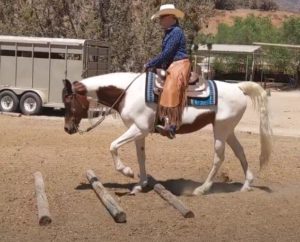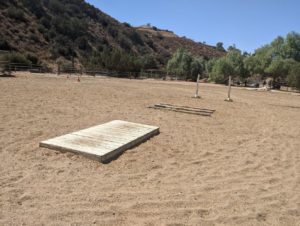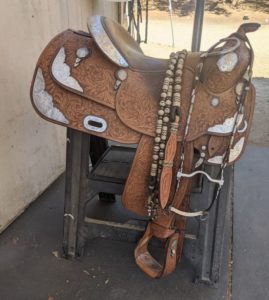
Are you one of the many equine enthusiasts who either loves showing your horse or would like to be able to show your horse? Taking your horse to a horse show can be a lot of fun. It’s a great way to test your skills and continue to work on becoming a better rider. You may be eager and ready to show your horse at an in-person horse show, but you might quickly find out that it’s not quite as simple as it sounds.
One major obstacle that you might run into, especially if you live in a rural area, is that you might not be able to locate an equestrian center or venue near you that puts on horse shows. If there is a place near you that has in-person shows, you’ll find out that competing in horse shows can be pricey – especially when you add up the costs of stalls, entry fees, haul-ins, hotel, etc. And, of course, there’s a lot of preparation, planning, packing and work that’s involved if you plan to be at the horse show for more than one day.
Luckily there’s a great alternative to showing in-person – welcome to virtual horse shows! Showing in a virtual horse show makes it easy for anyone to show their horse from home. It has opened up the world of competing to many riders (and horses) who have not been able to show in the past.
What Are Virtual Horse Shows
Virtual horse shows have been around for quite a while, though they have recently become more and more popular among riders. This is especially true since they allow horses and riders to showcase their talent from the comfort of their own property. Instead of spending the entire day (or longer) at an in-person equestrian event, you can choose a day and time that’s convenient for you to show your horse. You don’t have to worry about trailering your horse to the horse show and you don’t have to stress over inclement weather. You can show when you want to, where you want to and all at a time that works with your schedule. And what’s extra exciting, is that you’re competing against other riders from different locations – both U.S. and internationally!
Some virtual horse shows are put on by breed organizations, such as Arab or draft horse groups. Other virtual shows are open to all breeds of horses. Likewise, some shows are regional (such as West Coast), while others are open to competitors from all across the U.S. and internationally. English riders can compete virtually in equitation, dressage, hunt seat and jumping. Western riders can show virtually in reining, ranch riding, trail class, showmanship, western pleasure, barrel racing and more. Most virtual horse shows offer conformation and halter classes in addition to riding classes. And they also have lead line classes and short-stirrup classes for the younger equestrian riders.
Through internet or social media searching, you can easily find a virtual horse show that you can compete in. And most virtual horse shows offer ribbons, medals, and prizes to the winners of each class!
How To Enter
Once you’ve selected which virtual horse show you want to compete in, you’ll need to look at the class list and decide which classes you want to enter in. There are classes for all different levels of riders and horses, including green horses, green riders, amateur riders, amateur select and open riders. Along with the list of classes, there are also patterns posted for those classes where patterns are required (such as dressage, ranch trail and ranch riding). You’ll want to choose a class and pattern that best matches your current riding level and ability. If you can, you might want to enter several classes with a few of your riding buddies. That way you can put on a virtual horse show together and videotape your entries all on the same day.
There will be clear instructions on the virtual horse show website that will tell you what the deadline date is to enter the show. And there will also be deadline information as to when your actual videos are due. In most cases, the videos are due two weeks after the entry deadline date.
In order to enter in a virtual class, you’ll need to fill out an online form that’s on the virtual horse show website. They’ll ask you to provide some basic information, such as your full name, your email address, your phone number, the name of your horse and which classes you want to enter in. The cost of a class can be between $15.00 – $30.00 which is much lower compared to entry fees and costs associated with in-person horse shows. Most virtual shows ask that you pay when you sign up for the classes. They typically accept credit cards or payment via Venmo or PayPal. When you’ve successfully completed the form, you can then submit your entries online. You’ll soon receive email confirmation listing the classes that you’re competing in.
Preparing For Your Show
Once you’ve registered for your classes, you’ll want to practice, practice and practice. If you have an arena at your home or where you keep your horse, this would be a great place to practice and eventually videotape your entry. Otherwise, any flat ground or paddock will work as long as you have enough room to ride and perform the required maneuvers.
If your class has a pattern, it’ll be posted on the virtual horse website next to the class description. You can download and print the pattern and then practice the course layout with your horse. Ranch trail classes will require equipment such as poles, cones, markers and obstacles. You should follow the pattern and lay out all the elements in advance so you can practice before you videotape. That way you and your horse can become comfortable with the sequence of maneuvers prior to your show day.
Most classes ask that the videographer stand in or near the middle of the arena. You should also rehearse this with the videographer ahead of time. This will help you find the best spot for the videographer and camera. It will also help your horse get used to seeing someone standing in the arena while you are riding.
If there’s any special equipment or attire that you need for your show, you should also rehearse this in advance. For example, you might enter a class where you plan to wear chaps or chinks. Try wearing them a few times while you ride before you videotape your entry. That way both you and your horse can get used to the weight and feel of them before you show.
Learn the Rules
The rules for virtual horse shows may vary from one show to the next. So you’ll want to find out in advance what they are for the specific show or class that you’re competing in. You can find the rules on the virtual horse website, usually on the entry page next to the class list. Some virtual horse shows will also email the rules to you when you submit your entry form. Many virtual shows also post the rules on their social media page.
Most likely there will be riding attire standards, such as long sleeve shirts, long pants, and Western boots for Western riding classes. English classes will also have riding attire requirements that need to be adhered to. Additionally, there will be rules posted that apply to your tack. Common examples would be Western saddles for Western classes and English saddles for English classes. For Western classes, there will probably be additional rules that specify when snaffle bits are allowed as well as when two-handed riding is allowed. Also, most virtual horse shows either require or encourage riders under the age of 18 to wear ASTM approved helmets.
Virtual horse shows have video requirements as well, so you and your videographer (usually a friend or barn mate) should be clear on these rules. Most commonly, the videographer is required to stand in the middle or side of the arena. They will need hold the camera in landscape (sideways) mode. Virtual horse shows also require that no music is played over the videotape, though natural background noise is acceptable. Another requirement is that the videotape cannot be edited in any way. The video must be continuous, unretouched, and also indicate the date that it was videotaped. Edited videos that are entered into virtual horse shows will be disqualified.
Show Day
Virtual horse shows typically allow two weeks between the time of entry and the deadline date for when your video is due. This is where you get to pick a day where the weather is good and you’re ready to show off your skills. You’ll want to treat it as a real show – after all, it is a real show! Your horse, your tack and your show attire should all be clean and well-polished. You should carefully groom your horse so that he looks his best. If the weather is good, it would be an extra bonus if you could also give him a bath. You’ll also want to clean and polish your saddle, bridle and any other special equipment or tack that is required for your class.
On the day that you’re going to videotape your entry, go out to your arena or riding area and make sure that it’s clean and level. Check and clear any rocks or anything else that could get in the way of your ride. If possible, try watering down the ground to help minimize the dust.
For classes with patterns, check to ensure that your obstacles are in the proper location and are spaced correctly apart. If you’re at a place with other riders, try to pick a time when it’s fairly quiet. Or you can also just let others know that you’re videotaping your entry and ask if they can keep the noise level down while you’re showing. You can have friends on the sideline watch you show but coaching during the video is not allowed. Remember – your class entry is being judged by professional, qualified judges. So you should do your best to present a professional submission for their review and consideration.
On your show day, you’ll need the help of your friend who has a phone or camera with video capability. If you’re doing your virtual class with a few of your riding buddies, you can each take turns riding and videotaping each other. The videographer will need to stand at the position that’s marked on the pattern or on the class instructions. Ideally, you’ll want good lighting without too much glare from the sun. If you’re videotaping in an indoor arena, make sure you’re not backlit which would make it very difficult to see your ride. Also, the videographer will need to keep both you and your horse in frame during the entire ride. This is important so that the judges can properly see and score your entry.
Some patterns, such as ranch rail, require that a person announce the maneuvers during the entry. In this case, you’ll probably need another person in addition to the videographer to call out the required maneuvers.
As you start your show, the videographer can announce your name as they start to record. This not only helps the judges keep track of the entries, but it also tells you that the videotaping has started. Do your best to relax and have fun as you go through the maneuvers required for your class. If you make a mistake or go off pattern, don’t worry. It’s acceptable for you stop and re-record your entry.
Submitting Your Virtual Class Entry
Once you have completed your ride and reviewed the videotape, you’ll need to upload it to a video sharing platform. Most virtual horse shows ask for YouTube videos, though some virtual horse shows accept other video sharing options such as Vimeo, Dropbox or Google drive. Your video will need to be made public and needs to clearly indicate the date that it was videotaped.
On the virtual horse show website, there will be a section where you can then complete the submission form. You’ll need to enter your full name, the name of your horse, and the class (or classes) that you entered in. There will also be a section where you will paste the weblink to your video entry. After you’ve completed the submission process, you’ll receive an email confirmation that your entry has been received.
Most virtual horse shows will list the riders in each class on their website or on their social media page. This is actually very helpful because you can then see how many people entered in your class. Most virtual shows also publicly post all the videos submitted by the riders that entered in the show. This gives everyone a wonderful opportunity to see all the different styles of riding and arenas used across the U.S. and internationally. Plus, it’s also great for people who don’t show but enjoy the spectator part of horse shows.
Scoring and Results
Once the deadline date has been reached for the video submissions, the videos are then routed to qualified judges for review and scoring. Each video entry is judged individually, with the scores and comments from the judges marked on a scoresheet. Then, as soon as the judges have finished reviewing and scoring all of the video submissions, they will then determine the winners for each class.
Depending on the number of entries, it can take anywhere from one to four weeks to post the results. The scorecards for each rider are uploaded by class on the virtual horse website under the “results” section. You can then go to the website and look at your scorecard. Your results will be posted under your name in each class that you entered in. Your scorecard will tell you how you were judged on each maneuver along with specific comments from the judges about your ride. It’s great to see the direct feedback from the judges on what went well with your ride as well as areas of improvement. Also, for an additional fee, most virtual horse shows offer a 1:1 feedback session with one of the judges in case you want a more in-depth critique.
Awards
Awards are sent out in the mail at the end of the virtual horse show after the winners are selected. Some virtual shows, however, send awards after each class is judged and the winners of the class are selected. Prizes often include ribbons, medals, neck sashes, trophies, buckles, gift certificates and sometimes cash. Some virtual horse shows award the winners “points” that they can use to purchase gifts from their online store. Ribbons are usually awarded for 1st – 5th place and often there are special medals for champions or high point winners. A lot of the virtual horse shows have attracted sponsors, so gifts can also include clothing, halters, bridles and more!
Summary
Virtual horse shows are great for seasoned competitors as well as those riders who are new to showing. It’s not only less expensive than in-person shows, but there’s also the added benefit of conveniently showing from your own backyard. It’s great for people with busy schedules, weekend jobs, or live in remote areas without access to equestrian centers. Hopefully you’ll try entering a virtual show soon. Who knows, you might like it so much that you’ll keep doing it on your own or with your friends!








Leave a Reply